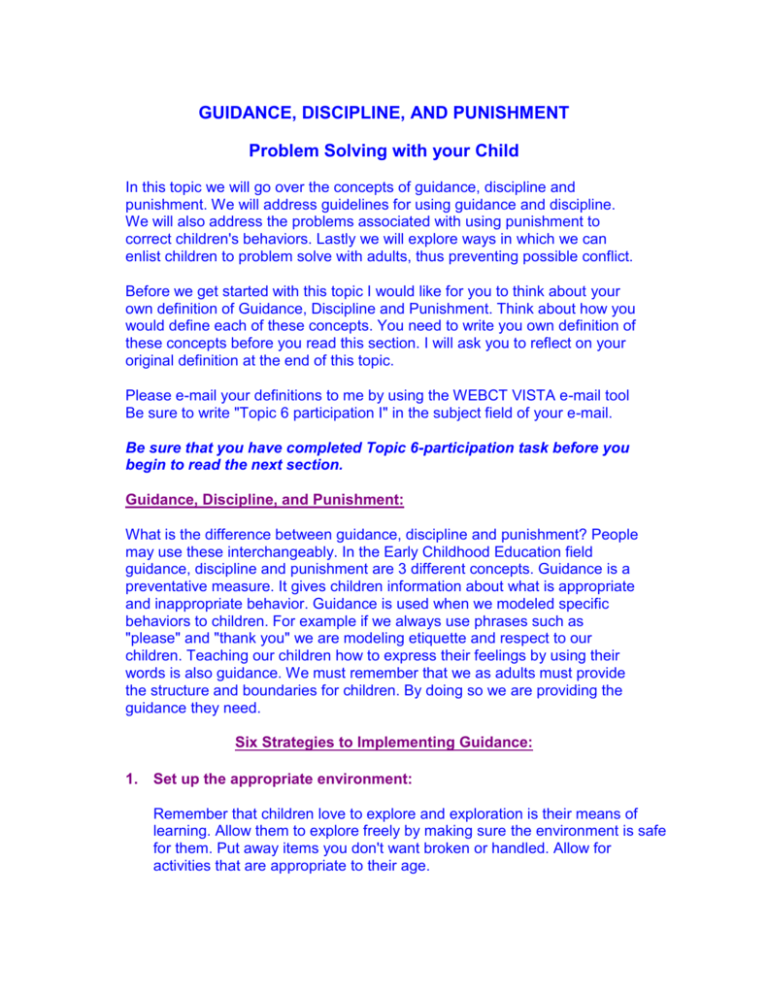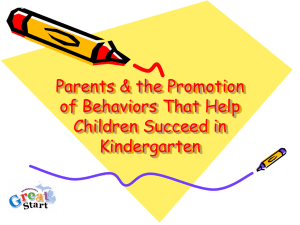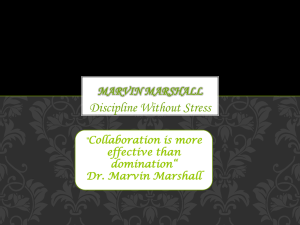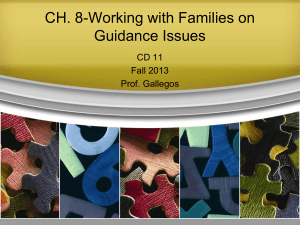GUIDANCE, DISCIPLINE, AND PUNISHMENT
advertisement

GUIDANCE, DISCIPLINE, AND PUNISHMENT Problem Solving with your Child In this topic we will go over the concepts of guidance, discipline and punishment. We will address guidelines for using guidance and discipline. We will also address the problems associated with using punishment to correct children's behaviors. Lastly we will explore ways in which we can enlist children to problem solve with adults, thus preventing possible conflict. Before we get started with this topic I would like for you to think about your own definition of Guidance, Discipline and Punishment. Think about how you would define each of these concepts. You need to write you own definition of these concepts before you read this section. I will ask you to reflect on your original definition at the end of this topic. Please e-mail your definitions to me by using the WEBCT VISTA e-mail tool Be sure to write "Topic 6 participation I" in the subject field of your e-mail. Be sure that you have completed Topic 6-participation task before you begin to read the next section. Guidance, Discipline, and Punishment: What is the difference between guidance, discipline and punishment? People may use these interchangeably. In the Early Childhood Education field guidance, discipline and punishment are 3 different concepts. Guidance is a preventative measure. It gives children information about what is appropriate and inappropriate behavior. Guidance is used when we modeled specific behaviors to children. For example if we always use phrases such as "please" and "thank you" we are modeling etiquette and respect to our children. Teaching our children how to express their feelings by using their words is also guidance. We must remember that we as adults must provide the structure and boundaries for children. By doing so we are providing the guidance they need. Six Strategies to Implementing Guidance: 1. Set up the appropriate environment: Remember that children love to explore and exploration is their means of learning. Allow them to explore freely by making sure the environment is safe for them. Put away items you don't want broken or handled. Allow for activities that are appropriate to their age. 2. Model appropriate behavior: Be a role model for your child. Behave as you expect your child to behave. 3. Re-Direct Energy: Be sure to provide several choices for children. Plan for activities that children can do outside. Be sure to allow children to let out their physical energy. 4. Provide Physical Presence: Be sure that you know what your children are doing and be sure that your children know you are close by. You may be able to prevent problematic behavior by simply getting physically close to your child or by providing physical touch. 5. Teach Expression of Feelings: Teach your child how to express anger by using his/her words instead of his/her hands. 6. Meet their Needs: Be sure to identify their needs and meet them. Are they hungry, tired, sick, and soiled? Let's now turn our attention to Discipline. What is discipline and when do we use it? Discipline is a corrective method. Discipline is an action we take after a child has behaved in an unacceptable manner. For example, if a child breaks a window he/she must pay for the damages. We must remember that the goal of discipline is to address and correct the inappropriate behavior. We must always separate the behavior from the child. Many people confuse discipline with punishment. When we use discipline we simply address the erroneous behavior by providing consequences. Strategies for Implementing Discipline 1. Honoring the Impulse: Sometimes we identify children?s behaviors as misbehaviors when in reality they are just following their developmental impulses. This is very common in toddlers and pre-verbal children. For example, a toddler whom drops his glass of juice on the floor may just be exploring the process of letting the glass go and seeing the juice spill. In a situation like this it is important to understand this process for this child. This doesn?t mean that you allow the child to continue to spill the juice over and over again. It would be important for you to provide information to your child as to what he/she is doing. For example, you might say, "It looks like you find the pouring of the juice fascinating." By saying this to your child you have begun to honor his/her impulse. Then, you proceed to let the child know that you prefer the juice stay on the table or in the glass. If the child persists on pouring the juice, you let her/him know that you will need to take the glass away, as this is unacceptable. 2. Sportscasting: This is a form of providing information by describing the events taking place. This strategy is useful when you are dealing with conflict between two children. It's essentially a running commentary: "I see that you are holding that toy very closely, I see Bob is grabbing the toy from you." 3. Facilitation: This strategy also works well with conflict between two children. It works well if you use it in conjunction with Sports-casting, " Bobby I see that are grabbing the toy from Johnny, is there another way to let him know you want to play with it?" This strategy encourages children to think of solutions and to verbalize their needs. This is a strategy that pre-schoolers and school age children will benefit from. 4. Using "I" Messages: "I" statements is a useful tool to use with children of all ages. When you use "I" statements with your child you model for your child that you have feelings and are able to express them. You also let your child know how their behavior affects you without using blame. 5. Giving Choices: This is also another strategy that can be used with younger children as well as teenagers. Providing choices for your children lets them know that your honor their sense of autonomy. Choices can be used for children testing your limits. "You can go out on a school night or Saturday night." 6. Natural Consequences: Children learn best through direct experience, allowing them to experience the impact of their actions can provide them with important information. For example, if a child chooses not to do his/her homework, he/she may get detention at school the next day. It is important that we allow our children to experience these consequences and that we do not rescue them. The natural consequence strategy is a powerful tool to teach children about the consequences of their actions. The exception to this is in cases where safety of the child is an issue. We should never allow our children to get hurt so that they can learn a lesson. More information on setting boundaries for children click on the following website: http://www.sote.qld.edu.au/articles/HowToSayNo1.html We discussed how discipline is a method that attempts to correct a child's inappropriate behavior. Punishment on the other hand attempts to attack the child's spirit and sense of self. Punishment does not separate the child from the behavior. It assumes that the child misbehaves because the child is intrinsically bad. Punishment is based on threats, fear, and corporal punishment. Janet Gonzalez-Mena (2002) identified several problems with using punishment with children. According to Mena, adults often use punishment to get even with children this then creates a feeling of retaliation on the part of the child. When parents use punishment, they are jeopardizing their relationship with their children as they begin to resent the parent. Mena as well as other researchers believe that using punishment with children only models aggressive behavior and it teaches them that violence is an acceptable manner to resolve conflict. Punishment also inhibits a child's sense of initiative. Children shy away from trying new things for fear that they will make a mistake and be punished for it. Effective parenting should include guidance and discipline only. It is important to know you children and to understand and meet their individual needs. Effective parents should learn how to guide and control behaviors without lowering children's self-esteem. Problem Solving with your Child Problem solving is an essential skill for children to learn. It is important for children to learn how to deal with conflict and find effective solutions. The best way for children to acquire this skill is for parents to teach them through modeling. The following website http://www.ehealthyparenting.com/problem_solving.html will take you through the six steps to problem solving. Remember that you can also use these steps with younger children. How was your original definition of guidance, discipline and punishment different or similar to the definitions in topic 6? Please email your answer to me by using the e-mail tool in WEBCT VISTA . Be sure to write "Topic 6 participation II" in the subject field of your e-mail.






